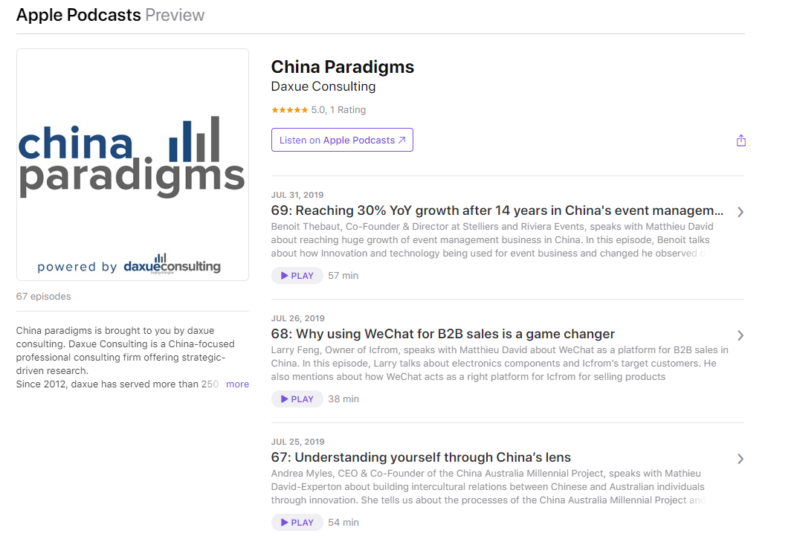Why VR brands should keep an eye on the Chinese market
When it comes to virtual reality (VR), all eyes are on China. Indeed, its market is developing far faster than anywhere else. An infographic made by Daxue Consulting shows that within four years, the world VR market will grow by 1000 %. In 2020, the virtual reality market in China is around 8 billion USD in size.
As proof, stores proposing an experience of virtual reality blossomed in all Chinese malls. It is a great opportunity for those who cannot afford a VR headset. Costing around 50 RMB, they can take place sitting comfortably in an egg shaped chair. The success of those stores is such that the Taiwanese smartphone maker HTC, which owns its range of VR set, said it would open 10,000 of such experience sites in China before December 2016.
Enthusiasm for virtual reality market in China
This decision of HTC is not surprising when one knows the potential of the virtual reality market in China. The ones who are likely to get the broadest share of the cake may be the Chinese producers: compared to their US competitors, they can produce quality devices in large quantity for a very competitive price. Hence, a hundred of devices are already available on the Chinese market with products by Baofeng Magic Mirror (Baofeng Mojing) and Dëe Poon as best sellers.
Those optimistic estimations may be explained by the curiosity of Chinese consumers for virtual reality. According to iResearch, they were 1.4 million to use VR devices in 2016, a figure that could be multiplied by five before 2018 to reach 7.3 million users. Main fields of application of virtual reality quoted by fans today are video and game, but they also expect applications in the sectors of social networks and education, reports a poll from iResearch.
China’s plan to lead in global VR market
In 2018 the Chinese government released a document that states how it wants to commit to the VR development in China. This document entitled “Guiding Opinions of the Ministry of Industry and Information Technology on Accelerating the Development of Virtual Reality Industry” and has been released by the Chinese Ministry of Industry and Information Technology.
In 2020, China expects to have a working VR ecosystem and a growing infrastructure to create VR products and services. In 2025, China plans to become the worldwide leader of the virtual reality industry. It includes having a flourishing ecosystem, with Chinese companies that will be highly competitive in the whole world. The government wants to see growth not only in manufacturing headsets but also in innovative technologies such as chips, screens, UX, 3D modeling, motion capture, data processing, positional tracking.
Growth projected in the Chinese VR market
The VR market in China is forecast to expand to 55.63 billion yuan (US$7.9 billion) by 2020. The compound annual growth rate of the VR market will likely reach 91.2 per cent.
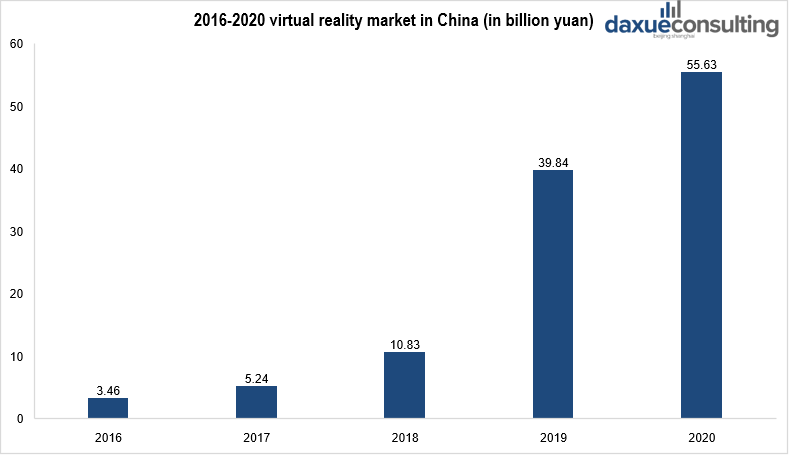
[Data Source: qianzhan, “2016-2020 virtual reality market in China (in billion yuan)”]
With the rapid development of the economy, VR market in China has a huge potential user group, providing a broad market demand. The rapid expansion of the user base will directly promote the development of the virtual reality market in China.
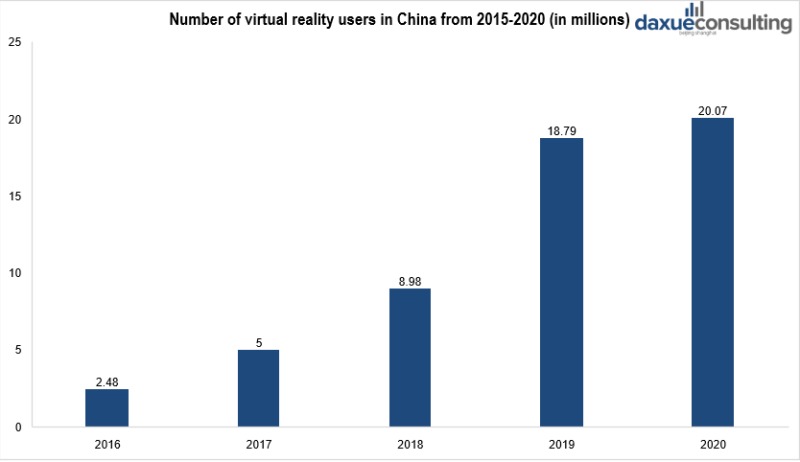
[Data Source: qianzhan, “Number of virtual reality users in China from 2015-2020 (in millions)”]
With the development of technologies, the prices of VR products will be refined, which will further promote the popularity of VR products. According to IDC China data, the consumption of China’s AR / VR industry in 2018 was 3 billion yuan. Experts predict a rapid growth trend from 2019-2023. The average annual compound growth rate will reach 77.8%. By 2023, the consumption will be over 65 billion yuan.
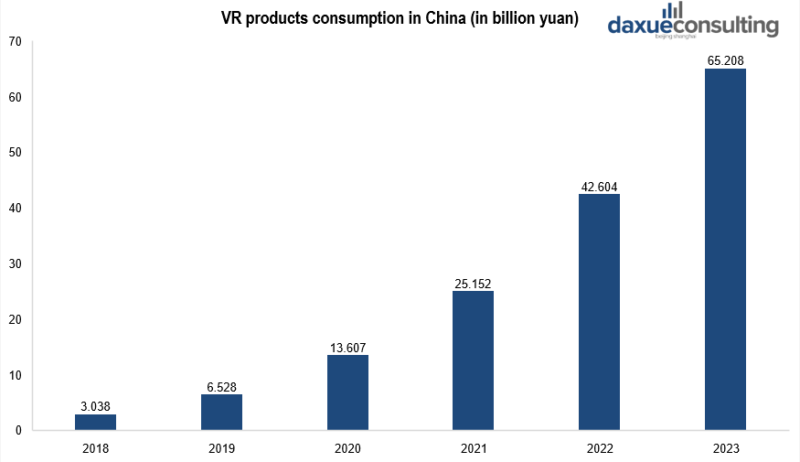
[Data Source: qianzhan, “VR products consumption in China (in billion yuan)”]
According to the forecast of iResearch, in 2021 VR games and VR film and television will become the two mainstream content segments, accounting for 34% and 32% respectively.

[Data Source: qianzhan, “Segments of virtual reality market in China (2021 forecast)”]
BAT has their eyes on the virtual reality market in China
Baidu, Alibaba and Tencent (or by their nickname “BAT”), the three giants of the Chinese Internet, are important players of the virtual reality scene. In fact, they are working to broaden the use of this technology far beyond users’ expectations. For instance, China’s first e-commerce group, Alibaba, would like to use virtual reality to improve the e-shopping experience. For web users, shopping on the streets of New-York would be possible without moving from one’s computer. Sellers would promote their products in three dimensions.
Tencent, which owns two of the largest Chinese social networks, would be thinking of a chat where participants would directly discuss in a virtual world. Finally, Baidu, China’s first search engine, is working on the production of content adapted to VR technology, which remains one of the main hurdles to the expansion of this technology today. To make those plans real, each of the three groups is heavily investing in specialized VR start-ups.
Streaming giant iQiyi: plans to enter millions of houses
In May 2018, Baidu stated that it wants to build the world’s largest Chinese virtual reality service through iQiyi. IQiyi has worked with more than 300 partners, including Chinese virtual reality maker Beijing Storm Technology. It also recently released an application that makes movies and games on iQiyi platforms compatible with head-mounted virtual reality devices. IQiyi is also launching live streaming concerts and making virtual reality movies.
Virtual reality video is a big part of the VR development in China. About 504 million Chinese consumers already use media streaming sites frequently, which may help VR live broadcasts quickly gain popularity. A survey by Niko Partners in 2016 found that half of Chinese consumers are interested in virtual reality, and 30% of consumers are willing to spend $200 on a VR device.
IQiyi ’s VR strategy focuses on film and television. IQiyi ’s founder, Gong Yu, said that virtual reality soon can enter millions of houses. He also announced the launch of the VR incentive plan that will cover more than 10 million Chinese VR users. Users can use the device to watch movies and shows from iQiyi’s app in a virtual cinema, complete with a high-resolution projection screen and theater seats. The headset also supports Steam and other platforms for gaming in China.
Alibaba: plans for virtual reality applications
Chinese e-commerce giant Alibaba has created 3D renderings for hundreds of products and will enable merchants to create their own virtual shopping experiences. In 2018, Alibaba launched a virtual reality shopping mall called Buy +. Alibaba claims that 30,000 users have registered on the platform within an hour after the release of Buy +. In addition, Alibaba has also launched a payment service that allows shoppers to use virtual reality technology to pay for virtual reality items by nodding. VR Pay technology uses biometric identification technology, such as identifying the unique voice of each consumer before authorizing payment for goods.
In 2018 Valentino has teamed up with Alibaba for a new virtual reality retail experience. The joint effort takes the form of a virtual store, which is a representation of a real Valentino pop-up shop that customers can explore in virtual reality. Valentino created the virtual experience to promote its new line of Garavani Candystud bags. The virtual reality store allows customers to explore the interior of a Valentino pop-up shop, letting them examine the pieces on display and purchase them.
Valentino is one of the major brands to be a part of Alibaba’s Luxury Pavillion. As China is one of the major markets for luxury brands from around the world, Alibaba is hoping to act as a conduit between Chinese customers and Western brands. Valentino’s new pop-up is one of its first major efforts to enter the VR market in China. Alibaba’s Luxury Pavilion is helping brands deliver experiences and services to top customers through the launch of a loyalty program.

[Source: cpp-luxury.com, Valentino at Alibaba’s Luxury Pavillion]
Tencent: expansion to VR market
Another Chinese tech giant Tencent is also investing in virtual reality content for video and games. Company is hosting live virtual reality concerts for music artists, and buying rights to 300 Japanese anime series. The next step is to expand to VR games industry. According to data from the China Internet Data Center, China will reach nearly 500 million online game players in 2020, and online game revenue increased from 143 billion yuan in 2017 to 251 billion yuan in 2018. They are potential users of the VR online games technologies.
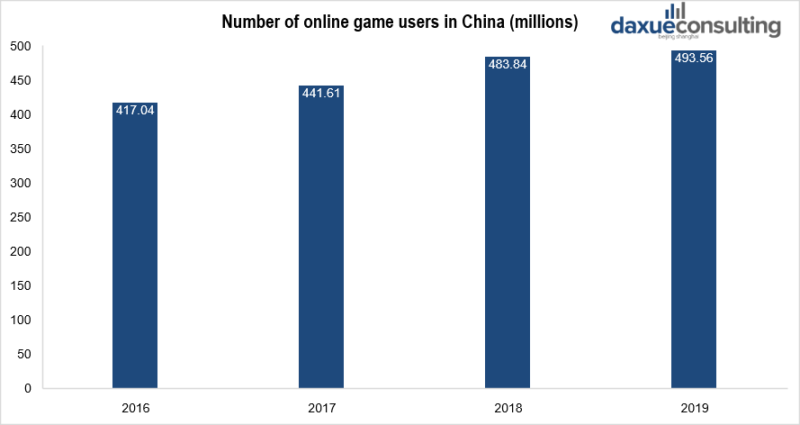
[Data Source: 199it.com, “Number of online game users in China (millions)”]
Tencent has also invested in Original Force, which creates computer-generated virtual reality content and develops virtual reality movies. Original Force also works with Pulse Evolution, which created a hologram of pop stars for concerts. These investments are strategic to Tencent. The tech giant needs attractive content to keep 1.3 billion active users on its WeChat and QQ instant messaging services for longer.
Future trends for virtual reality market in China
COVID-19: pandemic gives a boost to virtual reality
Spreading of coronavirus pandemic across the globe could be a push for the VR market in China. Covid-19 in China has pushed many people to use VR in ways they hadn’t before. Some people also started using VR devices again after leaving them idle for a long period of time. People can watch exercise videos on a TV or meet people in a conferencing app like Zoom. In China, where the coronavirus outbreak first appeared, some people have found more creative uses for VR tech. Some Chinese hospitals let doctors put on VR headsets to virtually visit potential Covid-19 patients in isolation wards.

[Data Source: baijiahao, “VR medicine market size in China forecast (in million US$)”]
VR development in China let people virtually visit popular tourist attractions. Chinese online tourism is gaining more and more customers during the pandemic. Property developers have also been relying on VR. Some have created apps to view homes virtually, helping to buttress sales as cities were locked down. During two weeks in February 2020, Chinese consumers took more than 3 million VR house tours, according to a report by online real estate company Beike. The numbers were more than nine times higher than in January.
As schools across the country cancelled courses due to COVID-19, officials developed plans to cope with longer-term closures. One such solution is launching VR conference platforms.
In February 2020, Lanvin, one of the oldest French fashion houses, revamped itself at Paris Fashion Week with emerging technology. The brand’s Fall/Winter 2020 runway show was broadcast using virtual reality technology to Chinese audiences with the help of the video platform iQiyi. In addition, the show was also livestreamed on the luxury e-commerce platform Secco, and hosted by a Paris-based Chinese influencer who provided live commentary.

[Source: Jing Daily, French high-fashion brand Lanvin, which is owned by Chinese Fosun group, has revamped itself at Paris Fashion Week with VR]
New 5G era of VR development
5G commercialization is opening up new spaces for a wider range of VR applications, benefiting more industrial practices that need real-time interaction. The transmission rate of 5G network can reach 10Gbps, which is 100 times more that of 4G. The delay in transmission can reach the level of 1ms. Сurrent 4G networks cannot meet the above performance requirements. 5G will greatly improve network performance. It is specifically reflected in transmission rates, delays, connection density and mobile speed.

[Data Source: qianzhan, “Comparison of global and Chinese wideband, 4G, and 5G networks”]
Zhang Lijun, vice president of Tencent, believes that under 5G, VR may become the third screen other than smartphones and TVs. Compared with mobile phones and TVs, VR has a wider field of vision and a more realistic experience. With the acceleration of 5G commercialization and the continuous advancement of chips, display technology and algorithms, the VR industry will usher in a new round of explosion.
China’s VR industry has a huge potential
China is one of the most active countries in terms of innovations in VR industry. VR development in China presents several characteristics. R&D and manufacturing system has already formed. China has produced more than 70% of high-end head-mounted VR displays in the world. The content resources are also constantly enriched. VR live broadcasts are becoming popular during major events such as the Spring Festival Gala and National Day celebrations. Experiential quality content is beginning to take shape. Especially when China officially entered the first year of 5G commercialization, it opened up a broad market space. Estimations say China will deliver the largest AR/VR spending in 2020 with $5.8 billion US.
Entering the Chinese market
On a dynamic market which BAT has a hold of, foreign competitors may have difficulties promoting their own products. For instance, between June 2014 and January 2016, Google sold 5 million of its VR Cardboard while in six months only, Baofeng’s sales prediction for its own set are about twice this amount. In this context, some foreign companies are trying to create partnerships with their Chinese counterparts in to facilitate their entry into this market. This is the case of Magic Leap which was able to persuade Alibaba to join the team as an investor. Nokia did the same when choosing the supplier of online videos LeEco for the launch of its virtual camera Ozo.
Those partnerships should enable foreign actors to understand the unique characteristics of the Chinese VR market. For instance, Chinese consumers would rather get themselves an experience of virtual reality in amusement parks or dedicated spaces (cybercafés etc.) rather than buying themselves a headset, which is often too expensive for a majority of consumers.
Author: Valeriia Mikhailova
Let China Paradigm have a positive impact on your business!
Listen to China Paradigm on iTunes
